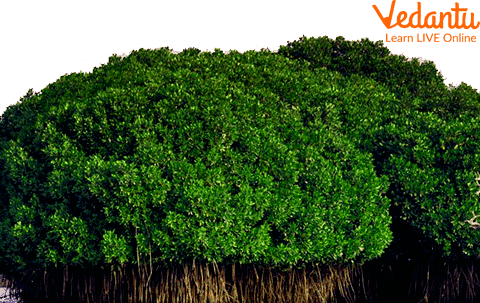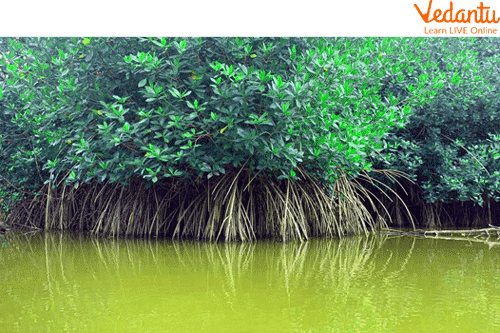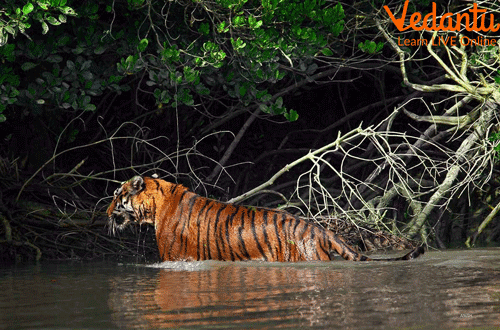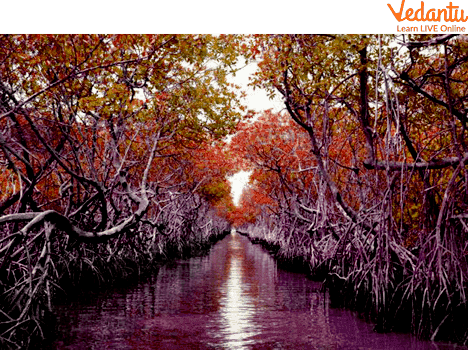




An Introduction to Mangrove Forests and Animals
Mangroves are a type of tree with roots and leaves that grow in saline water along the coast. They have a unique adaptation to living in saltwater; they use salt rather than water to suck up and transport nutrients. In this article, we will learn about the animals found in the mangrove forests. From mangrove adaptations to the watery environment to the predators they have to deal with, this post will enlighten you with a lot of information about these animals and their lives in the mangrove forest.

Mangrove
Mangrove Forests
Mangrove forests are known for their wet soil, humid climate, and salty surroundings. Mangrove forests are the only habitat for several offshore and coastal creatures. Additionally, it serves as a site for the fertilisation of various aquatic creatures, resulting in a high level of biodiversity.
Mangroves have evolved to have air-exposed roots because oxygen absorption is constrained in swampy wetlands. The tree species can withstand highly salinated water. They can adapt to severe environments because of their breathing roots and stilt roots. The most significant vegetation in regions with tide-influenced coatings that have accumulated mud and silt is seen in mangrove forests.

Mangrove Forest
Features of Mangroves
Mangroves can be little twigs or can reach heights of 130 feet (40 metres). The height of the common mangrove is approximately 30 feet (9 metres). The leaves of mangroves are usually green and could be fuzzy or waxy. The blossoms can either be white or yellow.
Mangrove Adaptations
Mangroves change their bodies and behaviours in a variety of ways to live in overly salty and unstable conditions. By filtration, storage, and excretion, the salt is controlled. Long subterranean cable roots of mangroves absorb nutrients and create a dense network, which contributes to their support system.
Many species have breathing roots called pneumatophores that may take in ambient oxygen to make up for the lack of it in the soil. Some plants have base buttress roots that provide support in sloppy soil. A few species possess stilt roots that extend from the base of the stem and bury themselves in the ground to sustain the plant.
Lenticel glands, which are found in many mangroves, allow for the gaseous exchange between plants as well as the atmosphere. Some plants have wax-coated leathery leaves that prevent freshwater from evaporating through the leaves during transpiration.
Mangroves use a special "vivipary" mechanism, unlike terrestrial plants, to ensure reproduction in a harsh environment. On mother plants, seeds sprout, growing propagules with simple root and branch structures. These propagules fall to the ground, embed themselves in the surrounding soil, and eventually develop into full-grown trees.
Animals Found in Mangrove Forests
Primates, sometimes known as long-nosed monkeys, live in Borneo's mangrove forests in Southeast Asia. Their distinctively long, pendulous noses, which they utilise to entice mates, are what they are known best for. Proboscis monkeys have distinctive noses, and their webbed feet enable them to swim away from predators when they are in the water.
In Australia's mangroves and Papua New Guinea's rainforests, fuzzy marsupials can be seen living in the dense canopy. They have lovely, thick woolly fur covering them from head to toe, and are about the size of a house cat. Marine mammals, also referred to as sea cows, spend their days grazing on the ocean floor. They are located in and around shallow waters and mangrove waterways in coastal locations.
Animals Found in a Mangrove Forest in India
The superb biodiversity of the mangrove forest in the Sundarbans is often praised. The 2,112 sq km mangrove forest area is on the West Bengal side. There is a big royal Bengal tiger population there. Other animals found in a mangrove forest in India are Gangetic dolphin, olive ridley turtle, saltwater crocodile, and mangrove horseshoe crab.

Royal Bengal Tiger of Sundarbans Mangrove Forests
In the Cuddalore district of Tamil Nadu, the Pichavaram mangrove forest is situated between the Vellar and Coleroon estuaries. Some of the birds that are commonly seen in the woodland are little egrets, pond herons, cormorants, and openbill storks. Nature lovers should visit one of India's most beautiful mangrove ecosystems.

Pichavaram Mangrove Forests
Summary
Mangroves are amazing ecosystems that can be found all over the world. While they are most commonly found in tropical and subtropical climates, mangroves can also be found in temperate and cold climates. These communities of trees and shrubs grow in salt water or brackish water environments, which creates a unique environment for the animals that live there.
In this article, we have looked at some animals found in a mangrove forest in India. Some of the animals that can be found living in mangrove forests include Proboscis monkeys, macaques, bears, deer, boas, tapirs and turtles. These animals have adapted to life in these unique ecosystems and offer visitors an insight into the unique adaptations that some species have made to live in wetter environments.
FAQs on Mangrove Animals and Forests - Features and Adaptations
1. What advantages do mangrove forests offer for mangrove animals?
The erosion brought on by storm surges, currents, waves, and tides is lessened by mangrove trees, which help to stabilise the coastline. By filtering out nutrients and pollutants from stormwater runoff before reaching coral reefs and seagrass habitats, mangroves preserve the purity of the water. A variety of wildlife species, including birds, deer, and honey bees, can find refuge in mangrove systems. Mangroves are essential to many birds' seasonal migrations. Even dead mangroves are significant because they give many bird species places to rest.
2. What makes mangroves distinctive?
The only tree species in the world that can endure saline water are mangroves. They use their waxy leaves to excrete salt that would otherwise be harmful, as is their approach. There have been at least 50 and possibly up to 110 species of mangroves, with heights ranging from 2 to 10 metres, according to estimates. All species have oblong or oval-shaped leaves, and they all prefer brackish environments. Mangroves also differ from other marginal habitats in that they are highly productive and energetic ecosystems.
3. What is the name of a mangrove forest where mangroves animals live?
Tropical and subtropical tidal environments are home to mangrove forests, which are also known as mangrove swamps or mangals. Estuaries and ocean shorelines are places where mangroves grow.
4. Where is the largest mangrove forest?
The largest mangrove forest is found in Bangladesh.









